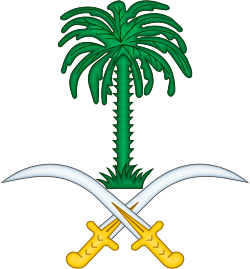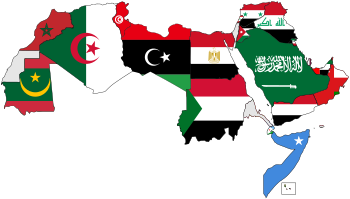Flag of Saudi Arabia
The flag of the Kingdom of Saudi Arabia (Arabic: علم المملكة العربية السعودية) is the flag used by the government of Saudi Arabia since 15 March 1973. It is a green flag featuring in white an Arabic inscription and a sword. The inscription is the Islamic creed, or shahada: "There is no god but Allah; Muhammad is the Messenger of Allah".
 لَا إِلٰهَ إِلَّا الله مُحَمَّدٌ رَسُولُ الله ("There is no god but Allah; Muhammad is the Messenger of Allah") | |
| Use | State and war flag, state and naval ensign |
|---|---|
| Proportion | 2:3 |
| Adopted | 15 March 1973 |
| Design | A green field with the Shahada or Muslim creed written in the Thuluth script in white above a horizontal sword, in which the tip was pointed to the hoist-side in the center.
 Reverse |
Design
The Arabic inscription on the flag, written in the calligraphic Thuluth script, is the shahada or Islamic declaration of faith:
- لَا إِلٰهَ إِلَّا الله مُحَمَّدٌ رَسُولُ الله
- lā ʾilāha ʾillā-llāh, muhammadun rasūlu-llāh
- There is no god but Allah; Muhammad is the Messenger of Allah."[1]
The green of the flag represents Islam and the sword stands for the strictness in applying justice.[2]
The flag is manufactured with identical obverse and reverse sides, to ensure the shahada reads correctly, from right to left, from either side. The sword also points to the left on both sides, in the direction of the script. The flag is sinister hoisted, meaning that when viewed from the obverse (front) side, it is hoisted to the left of the flagpole.[3]
The usual color of the flag's green was approximated by Album des pavillons as Pantone 330 C, while the color used on flags at United Nations is approximately Pantone 349. At the 2012 London Olympics, Pantone 355 was used.[4][5]
Use

Because the shahada is considered holy, the flag is not normally used on T-shirts or other items. Saudi Arabia protested against its inclusion on a planned football to be issued by FIFA, bearing all the flags of the participants of the 2002 FIFA World Cup. Saudi officials said that kicking the creed with the foot was completely unacceptable. Similarly, an attempt by the U.S. military to win favour with children of the Khost Province of Afghanistan by distributing footballs adorned with flags, including that of Saudi Arabia, ended in demonstrations.[6]
The flag is never lowered to half-mast as a sign of mourning, because lowering it would be considered blasphemous.[7] Similarly, the flags of Afghanistan, Somaliland, and Iraq are also never at half-mast.
The normal flag cannot be hoisted vertically according to Saudi legislation. Special vertical flags are manufactured where both the inscription (the creed) and the emblem (the sword) are rotated, although this is rare, as most Arab countries traditionally do not hoist flags vertically.[5]
History
The precursor states to Saudi Arabia were Nejd and Hejaz. The state flag of Nejd followed today's Saudi flag pattern very closely. The state of Hejaz followed the patterns seen in countries like Palestine and Sudan. From 1902 until 1921 a different Arabic inscription was used. One of the primary opponents to the Saudis was the Emirate of Jabal Shammar of the Al Rashid family in the north of the peninsula, until their defeat in 1921.
 Flag of the Emirate of Diriyah from 1744 to 1818 and Flag of the Emirate of Nejd from 1822 to 1891
Flag of the Emirate of Diriyah from 1744 to 1818 and Flag of the Emirate of Nejd from 1822 to 1891 Flag of the Emirate of Jabal Shammar from 1835 to 1921
Flag of the Emirate of Jabal Shammar from 1835 to 1921 Flag of the Emirate of Riyadh from 1902 to 1913
Flag of the Emirate of Riyadh from 1902 to 1913



.svg.png) Flag of Nejd as part of the Kingdom of Hejaz and Nejd from 1926 to 1932
Flag of Nejd as part of the Kingdom of Hejaz and Nejd from 1926 to 1932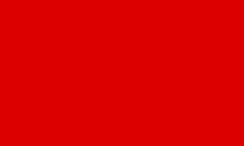 Provisional flag of the Kingdom of Hejaz from 1916 to 1917
Provisional flag of the Kingdom of Hejaz from 1916 to 1917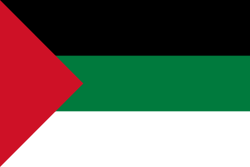 Flag of the Kingdom of Hejaz from 1917 to 1920, based on the flag of the Arab Revolt
Flag of the Kingdom of Hejaz from 1917 to 1920, based on the flag of the Arab Revolt Flag of the Kingdom of Hejaz from 1920 to 1926 and flag of Hejaz as part of the Kingdom of Hejaz and Nejd from 1926 to 1932
Flag of the Kingdom of Hejaz from 1920 to 1926 and flag of Hejaz as part of the Kingdom of Hejaz and Nejd from 1926 to 1932.svg.png) Flag of the Idrisid Emirate of Asir from 1909 to 1927
Flag of the Idrisid Emirate of Asir from 1909 to 1927.svg.png) Flag of the Idrisid Emirate of Asir from 1927 to 1930
Flag of the Idrisid Emirate of Asir from 1927 to 1930 Flag of the Sheikdom of Upper Asir from 1916 to 1920
Flag of the Sheikdom of Upper Asir from 1916 to 1920
Past flags
.svg.png)
The Al Saud, the ruling family of Saudi Arabia, has long been closely related with Muhammad ibn Abd al-Wahhab. He and the people who followed him, since the 18th century, had used the shahada on their flags.[8] In 1921 Abdulaziz Abdulrahman Al-Saud, leader of the Al Saud and the future founder of the Kingdom of Saudi Arabia, added a sword to this flag.[8] The design of the flag was not standardized prior to March 15, 1973, and variants with two swords and/or a white vertical stripe at the hoist were frequently used. By 1938, the flag had basically assumed its present form, except the sword had a different design (with a more curved blade) and it, along with the shahada above, took up more of the flag's space.
.svg.png) Flag of Saudi Arabia from 1932 to 1934, with white stripe on the hoist
Flag of Saudi Arabia from 1932 to 1934, with white stripe on the hoist.svg.png) Flag of Saudi Arabia from 1934 to 1938, with a thinner white stripe
Flag of Saudi Arabia from 1934 to 1938, with a thinner white stripe.svg.png) Flag of Saudi Arabia from 1938 to 1973, with no stripe
Flag of Saudi Arabia from 1938 to 1973, with no stripe
Royal Standard
The Royal Standard consists of a green flag, with an Arabic inscription and a sword featured in white, and with the national emblem embroidered in gold in the lower right canton of the year 1973.
The script on the flag is written in the Thuluth script. It is the shahada or Islamic declaration of faith:
- لَا إِلٰهَ إِلَّا الله مُحَمَّدٌ رَسُولُ الله
- lā ʾilāha ʾillā-llāh, muhammadun rasūlu-llāh
- There is no god but Allah; Muhammad is the Messenger of Allah[9]
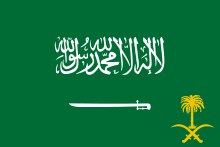
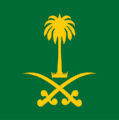 Royal Standard of the King of Saudi Arabia. (Ratio: 1:1)
Royal Standard of the King of Saudi Arabia. (Ratio: 1:1)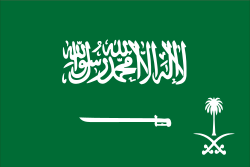
.svg.png)
.svg.png)
.svg.png) Royal Standard of the King (1938-1953)
Royal Standard of the King (1938-1953)
(Ratio: 1:1).svg.png)
.svg.png) Royal Standard of the King (1953-1964)
Royal Standard of the King (1953-1964)
(Ratio: 1:1).svg.png)
.svg.png) Royal Standard of the King (1964-1973)
Royal Standard of the King (1964-1973)
(Ratio: 1:1)
Other flags
The civil ensign, for use by merchant vessels at sea, is a green flag with the state flag in the canton with a white border. The royal standard is the state flag with the palm tree and swords in the canton.
.svg.png)



.svg.png)








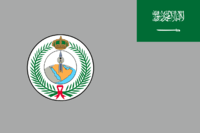

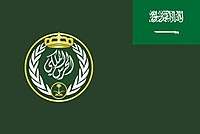



See also
References
- "About Saudi Arabia: Facts and figures". The Royal Embassy of Saudi Arabia, Washington D.C. Archived from the original on 2012-04-17. Retrieved 2016-08-05.CS1 maint: unfit url (link)
- Eriksen, Thomas; Jenkins, Richard (2007). Flag, Nation and Symbolism in Europe and America. p. 171. ISBN 9780415444040. Retrieved 3 October 2012.
- Saudi Arabia: The Reverse of the Flag, FOTW Flags Of The World, 3 June 2019. Accessed 2 May 2020.
- UN Map Library
- Saudi Arabia, FOTW Flags Of The World, 19 January 2008. Accessed 13 May 2009.
- Leithead, Alastair (2007-08-26). "'Blasphemous' balls anger Afghans". BBC News Online. Retrieved 2007-08-26.
- "Saudi King Fahd is laid to rest". BBC News. 2 August 2005.
- Firefly Guide to Flags of the World. 2003. p. 165. ISBN 978-1552978139. Retrieved 12 September 2012.
- "About Saudi Arabia: Facts and figures". The Royal Embassy of Saudi Arabia, Washington D.C. Archived from the original on 17 April 2012. Retrieved 24 April 2012.
External links
| Wikimedia Commons has media related to National flag of Saudi Arabia. |
